A seasonal calendar for vegetables gives you a good overview of when which vegetables are ready to be harvested. Everything about the vegetable season outdoors, in the greenhouse and from storage can be found here.

Fresh fruit and vegetables are not only delicious, they are also extremely healthy. At the same time, you protect the environment with seasonal purchases or growing your own vegetables, because long transport routes from warmer countries from the Harvesting and selling in the supermarket are no longer necessary - no wonder that more and more people prefer fresh fruit and vegetables from the current season to buy. But what is actually ready for harvest at what time or available from storage? This can be remedied by a seasonal vegetable calendar, in which you can see at a glance which species are from which cultivation - whether from the Outdoors, from protected cultivation, from controlled conditions in the greenhouse or from storage - especially in our latitudes have season.
tip: In addition to the ripening time of seasonal vegetables, it is also important to know when which types of fruit are available in our latitudes. In our article Seasonal calendar for fruit you will find a list of the months in which certain types of fruit ripen.
contents
- Seasonal calendar for vegetables in January
- Seasonal vegetables in February
- Seasonal vegetables in March
- April: Which vegetables are in season now?
- Seasonal vegetables in May
- Seasonal calendar for vegetables in June
- Seasonal vegetables in July
- Which vegetables are in season in August?
- Seasonal vegetables in September
- Seasonal calendar for vegetables in October
- November: Which vegetables are in season now?
- Seasonal vegetables in December
Seasonal calendar for vegetables in January
Although January doesn't necessarily offer the best growing conditions with snow and cold - some frost tolerant veggies like Kale (Brassica oleracea var. sabellica), leek (Allium porrum), Brussels sprouts (Brassica oleracea var. gemifera), savoy (Brassica oleracea convar. capitata var. sabauda) and sugarloaf (Cichorium intybus var. foliosum f. cylindricum) can still be harvested outdoors. In frost-free weather, the thick storage tubers of the Jerusalem artichokes (Helianthus tuberosus) ready for harvest, because they survive the winter in the ground and can be dug up fresh until March. Thrive in sheltered cultivation under fleece, in polytunnels or unheated greenhouses Lamb's lettuce (Valerianella locusta), arugula (Eruca sativa), winter posteline (Claytonia perfoliata) and winter cress (Barbarea vulgaris) slowly but easily. Chinese cabbage (Brassica rapa subsp. pekinensis) and Brussels sprouts are also grown under sheltered conditions in winter.

Most seasonal vegetables in January come from storage. Root and tuber vegetables in particular can be kept fresh for many months at cool temperatures and are available to us almost indefinitely until spring. Coming from camp in January carrots (Daucus carota), parsnip (Pastinaca sativa), parsley root (Petroselinum crispum subsp. tuberosum), radish (Raphanus sativus var. Niger), celery (Apium graveolens), salsify (Scorzonera hispanica), sugar loaf and various types of cabbage such as Red cabbage (Brassica oleracea convar. capitata var. rubra), cabbage (Brassica oleracea convar. capitata var. Alba) and savoy. potatoes (Solanum tuberosum) also belong to the seasonal vegetables in January thanks to their good storability, as well as pumpkin (Cucurbita), turnip (Brassica napus subsp. rapifera), Beetroot (Beta vulgaris), Jerusalem Artichoke, onions (Allium cepa) or garlic (Allium sativum).
become all year round Chicory (Cichorium intybus var. foliosum) and mushrooms (Agaricus) cultivated in darkened, warm and humid rooms until ready for harvest. Also the garden cress (Lepidium sativum) and other herbs like chives (Allium schoenoprasum), dill (Anethum graveolens) or parsley (Petroselinum crispum) are cultivated in the greenhouse all year round as pots or as cut and bundled herbs.
Summary of seasonal vegetables for January:
- Outdoors: kale, leeks, Brussels sprouts, Jerusalem artichoke, savoy cabbage, sugar loaf
- Protected cultivation: Chinese cabbage, lamb's lettuce, Brussels sprouts, rocket, winter cress, winter cornflower, sugar loaf
- Greenhouse/climate controlled rooms: mushroom, chicory, dill, garden cress, parsley, chives
- Storage: Chinese cabbage, carrot, potato, garlic, celeriac, pumpkin, parsnip, parsley root, Radish, beetroot, red cabbage, black salsify, pointed cabbage, swede, Jerusalem artichoke, white cabbage, savoy cabbage, sugar loaf, onion

Seasonal vegetables in February
February slowly heralds the end of winter with often frosty temperatures and changeable weather between plus and minus degrees. However, there are numerous robust vegetables that are harvested fresh from the field, from sheltered cultivation or in the greenhouse at this time. Seasonal vegetables grown outdoors in February continue to be kale and Brussels sprouts, savoy cabbage, sugar loaf, leeks and Jerusalem artichokes. Similar to January, cabbage types (Brassica) – but root and tuber vegetables as well as onions and garlic remain available. Sugar loaf, Chinese cabbage, rocket, lamb's lettuce, winter postelein and Barbarakraut from protected cultivation still ensure fresh green on the table.
Summary of seasonal vegetables February:
- Outdoors: kale, leeks, Brussels sprouts, Jerusalem artichoke, savoy cabbage, sugar loaf
- Protected cultivation: Chinese cabbage, lamb's lettuce, Brussels sprouts, rocket, winter cress, winter cornflower, sugar loaf
- Greenhouse/ climatically controlled rooms: mushroom, chicory, garden cress
- Storage: Chinese cabbage, carrot, potato, garlic, celeriac, pumpkin, parsnip, parsley root, Radish, beetroot, red cabbage, black salsify, pointed cabbage, swede, Jerusalem artichoke, white cabbage, savoy cabbage, sugar loaf, onion
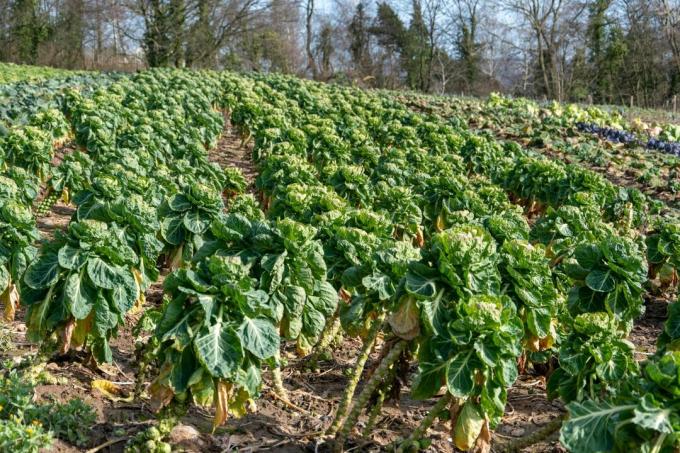
Seasonal vegetables in March
The first new types of vegetables start in March and bring spring to your plate. Typical seasonal vegetables in March are the wild garlic (Allium ursinum), also can watercress (nasturtium) and leeks can be harvested outdoors. In protected cultivation, other leafy vegetables such as lamb's lettuce, rocket, winter cress and winter purslane thrive. New to come now radish (Raphanus sativus var. sativus), radish, the first salads (Lactuca sativa) as spinach (Spinacia oleracea). Mushrooms, chicory and garden herbs are in season all year round. Various types of cabbage, root and tuber vegetables, onions and garlic are also available from stock.
Summary of seasonal vegetables for March:
- Outdoor: wild garlic, watercress, leek
- Protected cultivation: lamb's lettuce, radishes, radish, rocket, lettuce, spinach, winter cress, winter urchin
- Greenhouse/climate controlled rooms: mushroom, chicory, lettuce, garden cress, herbs
- Storage: carrot, potato, garlic, celeriac, pumpkin, parsnip, parsley root, beetroot, red cabbage, black salsify, pointed cabbage, swede, white cabbage, savoy cabbage, onion
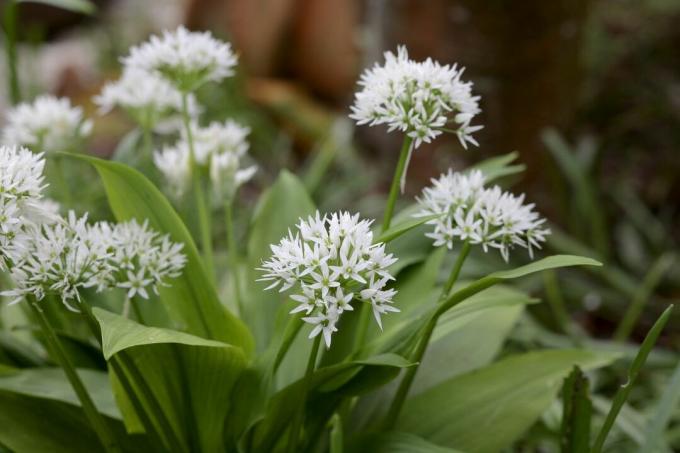
April: Which vegetables are in season now?
Seasonal vegetables in April from the field include wild garlic, cress, leeks, radishes and lettuce as well as spinach. You can freshen up from protected cultivation from mid-April Kohlrabi (Brassica oleracea var. gongylodes), cauliflower (Brassica oleracea var. botrytis) and asparagus (Asparagus officinalis) be happy. chard (Beta vulgaris subsp. vulgaris) and sorrel (rumex) join the numerous leafy greens from protected cultivation. If you have some knowledge of plants, you can already eat numerous edible wild herbs such as stinging nettle (Urtica), wood wood sorrel (Oxalis acetosella) or goutweed (Aegopodium podagraria) collect. Shelf-stable root, cabbage, and tuber vegetables harvested the previous fall still enrich our diet.
Summary of seasonal vegetables April:
- Outdoors: wild garlic, watercress, leeks, radishes, lettuce, spinach, wild herbs
- Protected cultivation: cauliflower, lamb's lettuce, kohlrabi, chard, radishes, rocket, sorrel, lettuce, asparagus, spinach, winter cress, winter cornflower
- Greenhouse/ climatically controlled rooms: mushrooms, chicory, garden cress, herbs
- Storage: carrot, potato, garlic, celeriac, parsnip, parsley root, beetroot, red cabbage, pointed cabbage, swede, white cabbage, savoy cabbage, onion
tip: Also a phenological calendar helps you to find the right times for certain gardening tasks. You can find out what this is all about and how such a calendar works in our special article.
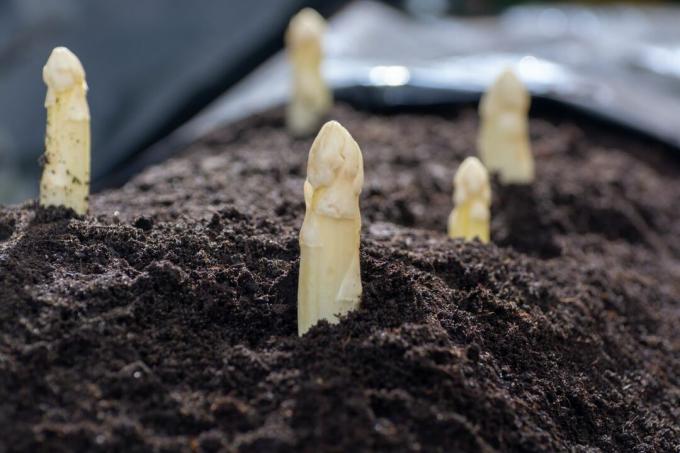
Seasonal vegetables in May
May is the season for vegetables such as asparagus, early cauliflower and broccoli (Brassica oleracea var. italiana), kohlrabi, radishes and chard straight from the field. Various salads, spinach and the last wild garlic come out of the bed or from the field in May. early peas (Pisum sativum), spring onions (Allium) and first turnips like that turnip (Brassica rapa subsp. rapa var. majalis) enrich the menu. In addition to various leafy vegetables and kohlrabi, the first early varieties of cabbage, as well as garlic, carrots, fennel (Foeniculum vulgare) and celery are ripe and are harvested from protected cultivation from the end of May.
In the greenhouse, commercial vegetable farms are the first to ripen tomatoes (Solanum lycopersicum), paprika (Capsicum annum) and cucumbers (Cucumis sativus) and will soon be ready for harvest. basil (Ocimum basilicum) thrives in the warm greenhouse and soon delights with spicy foliage. In the unheated greenhouse, on the other hand, the planting of the vegetables that need warmth does not take place until May. Wild herbs are now available in many places and enrich the vegetable season in May. Dandelion (Taraxacum) and Chickweed (Stellaria) are still considered by many weed, but are actually a wonderful addition to fresh salad. Both are readily available in May.
Summary of seasonal vegetables in May:
- Outdoors: wild garlic, cauliflower, broccoli, peas, lamb's lettuce, spring onions, radishes, radishes, rocket, lettuce, asparagus, turnips, spinach, wild herbs
- Protected cultivation: endive, fennel, carrot, garlic, kohlrabi, chard, sorrel, pointed cabbage, celery, white cabbage
- Greenhouse/climate controlled rooms: mushroom, chicory, garden cress, cucumber, pepper, tomato, basil
- Storage: carrot, potato, celeriac, beetroot, red cabbage, swede, white cabbage, savoy cabbage, onion
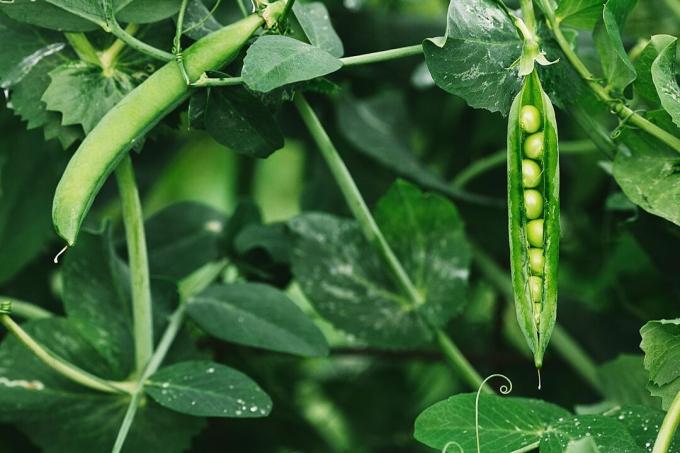
tip: If you prefer a monthly, tabular overview of seasonal fruit and vegetables, you can download our Plantura seasonal calendar to buy. In each month there are selected, lovingly hand-designed types of fruit and vegetables, so that the seasonal calendar is also ideal as a gift.
Seasonal calendar for vegetables in June
The vegetable season in July really gets off to a flying start outdoors: various types of cabbage, broad beans (Vicia faba), Peas, beans (Phaseolus vulgaris) thrive and can be harvested soon. Various types of carrots, the first new potatoes, garlic, celeriac, fennel, beetroot and turnips are now finally suitable for consumption. oak leaf – (Lactuca sativa var. crispa) and iceberg lettuce (Lactuca sativa var. capitata) ensure diversity among leafy vegetables such as chard, lamb's lettuce and rocket. Outdoor herbs such as parsley and chives are now ready to be harvested in the fields and beds. In addition to cucumbers, tomatoes and peppers, the warmth-loving ones are now also ripening in the greenhouse and in sheltered cultivation aubergine (Solanum melongena) and the zucchini (Cucurbita pepo var. giromontiina) approach. For the asparagus, however, the season ends in June - it will be available from St. John's Day on the 24th. Traditionally not harvested in June.
Summary of seasonal vegetables June:
- Outdoors: Cauliflower, broccoli, broad beans, endive, peas, lamb's lettuce, fennel, spring onions, carrots, potatoes, garlic, celeriac, Kohlrabi, chard, radishes, radishes, beetroot, red cabbage, rocket, salads, asparagus, turnips, spinach, pointed cabbage, celery, onions, wild and kitchen herbs
- Protected cultivation: aubergines, cucumbers, peppers, tomatoes, savoy cabbage, courgettes, basil
- Greenhouse/climate controlled rooms: mushroom, chicory, garden cress, aubergine, cucumber, pepper, tomato, basil
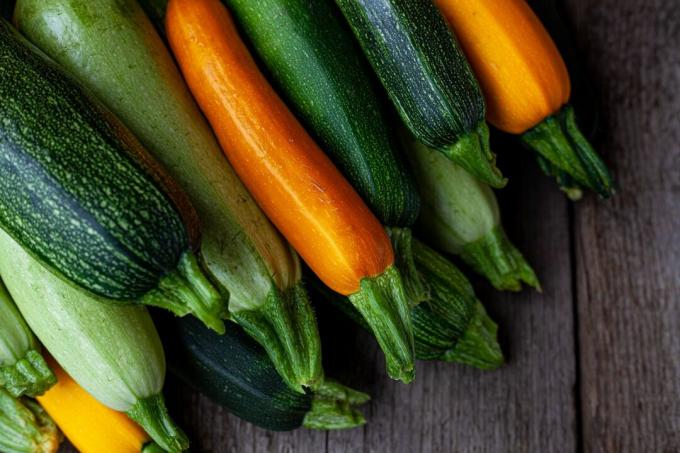
Seasonal vegetables in July
What started well in June continues just as well in July: the seasonal vegetables mainly come from the field. Peas and beans have numerous pods, cauliflower, broccoli and other types of cabbage as well as zucchini provide vitamin-rich supplies of fresh vegetables. Tuber vegetables such as fennel, celery, beetroot, turnips and potatoes ripen. The first onions, garlic and spring onions are ready to be harvested. Chinese cabbage (Brassica rapa subsp. pekinensis) and radicchio (Cichorium intybus var. foliosum) migrate from the field to the kitchen. From July onwards, cucumbers no longer only come from the greenhouse or from protected cultivation, but from the field or from the bed. So there is twice as much reason to be happy: both lettuce and pickling cucumbers can now be harvested. open field tomatoes, chillies (capsicum) and peppers also produce a bountiful harvest.
Summary of seasonal vegetables for July:
- Outdoors: Cauliflower, beans, broccoli, chili, broad beans, endive, peas, lamb's lettuce, fennel, spring onions, cucumber, carrot, potato, garlic, celeriac, kohlrabi, Swiss chard, peppers, radicchio, radishes, radishes, beetroot, red cabbage, rocket, salads, turnips, spinach, pointed cabbage, celery, tomatoes, onions, zucchini, savoy cabbage, wild and kitchen herbs
- Protected cultivation: aubergine, chili, cucumber, pepper, tomato, basil
- Greenhouse/climate controlled rooms: mushroom, chicory, garden cress, aubergine, cucumber, pepper, tomato, basil

Which vegetables are in season in August?
August slowly makes us think of the end of summer - but a wide variety of vegetables continue to come to us, harvested directly from the field. In addition to the tireless types of cabbage, these also include numerous turnips, onion plants, tuber vegetables and salads. August even offers space for exotic and almost forgotten vegetables – artichoke (Cynaracardunculus var. scolymus) and sweetcorn (Zea mays convar. saccharata) now thrive and complement the variety of vegetables on the grill. First leek plants are ready for harvest, and so is the Pak choi (Brassicarapa subsp. chinensis) is a typical seasonal vegetable in midsummer in the fields and in beds. From the end of August, delicious wild-collected edible mushrooms are available, including chanterelle and porcini mushrooms.
Eggplants, chili and peppers as well as cucumbers and tomatoes are still being harvested diligently in the greenhouse and in sheltered cultivation.
Summary of seasonal vegetables August:
- Outdoors: artichoke, cauliflower, beans, broccoli, chili, broad beans, endive, peas, lamb's lettuce, fennel, spring onions, Cucumber, carrot, potato, garlic, celeriac, kohlrabi, leek, corn, chard, pak choi, paprika, radicchio, radish, radish, Beetroot, red cabbage, rocket, lettuce, turnip, spinach, pointed cabbage, celery, tomato, onion, zucchini, savoy cabbage, wild and kitchen herbs, mushrooms
- Protected cultivation: aubergine, chili, cucumber, pepper, tomato, basil
- Greenhouse/climate controlled rooms: mushroom, chicory, garden cress, aubergine, cucumber, pepper, tomato, basil

Seasonal vegetables in September
In line with the falling temperatures, we can look forward to the number one autumn vegetable in September: finally the variously shaped pumpkins (Cucurbita) our beds. Stored vegetables such as the slow-growing parsnip, black salsify and turnips are also ready to be harvested from September and eaten fresh or stored for the cold winter months. A classic seasonal vegetable in September is the beetroot, which is sometimes very colourful. Numerous types of cabbage, lettuce and root vegetables such as radishes and carrots are now harvested outdoors, as well as onions and garlic, as well as spring onions and leeks. While heat-loving vegetables such as peppers and aubergines are slowly approaching the end of their lives, numerous are Vegetables are first sown or planted in the fall to provide us with vitamins and nutrients as winter vegetables late in the year supply. The mushroom season with porcini and chanterelles, on the other hand, really starts in September.
Summary of seasonal vegetables September:
- Outdoor: artichoke, cauliflower, beans, broccoli, chili, endive, peas, lamb's lettuce, fennel, spring onion, cucumber, carrot, potato, Garlic, celeriac, kohlrabi, pumpkin, leek, corn, chard, pak choi, paprika, parsnip, radicchio, radish, beetroot, red cabbage, Rocket, black salsify, salads, turnip, spinach, pointed cabbage, celery, swede, tomato, onion, courgettes, savoy cabbage, wild and kitchen herbs, mushrooms
- Protected cultivation: aubergine, chili, cucumber, pepper, tomato, basil
- Greenhouse/climate controlled rooms: mushroom, chicory, garden cress, aubergine, cucumber, pepper, tomato, basil

Seasonal calendar for vegetables in October
Now that the temperatures are dropping again, the first plants are getting too cold again - cucumbers, peppers and aubergines only reliably bear fruit in October in the greenhouse. Seasonal vegetables in October are mainly stored vegetables for long, cold winters: stored carrots, last potatoes, garlic, Celeriac, pumpkins, leeks, parsnips and root parsley, along with black salsify, Jerusalem artichokes and turnips like them fall turnip (Brassica rapa subsp. rapa) as well as numerous head cabbage species. An leafy greens are outdoors tattoo (Brassica rapa convar. narinosa), endive, lamb's lettuce, spinach, radicchio and rocket ready to harvest.
The outdoor season is ending for zucchini, celery and tomatoes. In October, dried pods of bean varieties are harvested as dry beans and popcorn corn (Zea mays convar. microsperm), which will last for years if dried properly. By the end of October, the last fruits of cucumber, pepper, aubergine and chili are harvested in protected cultivation before the plants go to the compost.
Summary of seasonal vegetables October:
- Outdoors: Cauliflower, broccoli, chili, endive, lamb's lettuce, fennel, spring onions, carrots, potatoes, garlic, celeriac, kohlrabi, Pumpkin, leek, popcorn corn, chard, pak choi, parsnip, radicchio, radishes, radish, beetroot, red cabbage, rocket, black salsify, salads, Turnip, spinach, pointed cabbage, celery, swede, tatsoi, tomato, Jerusalem artichoke, onion, courgettes, savoy cabbage, root parsley, wild and kitchen herbs, mushrooms
- Protected cultivation: chili, cucumber, pepper, tomato, basil
- Greenhouse/climate controlled rooms: mushroom, chicory, garden cress, aubergine, cucumber, pepper, tomato, basil
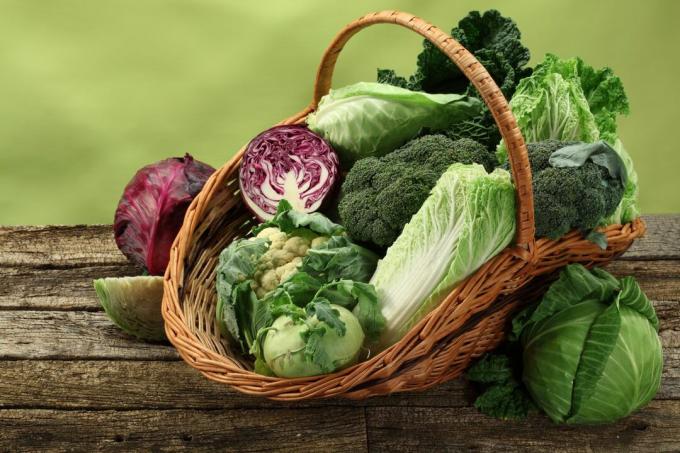
November: Which vegetables are in season now?
The bed is slowly becoming emptier again: in November, many types of vegetables disappear due to the low temperatures. The last spring onions, beets, late cauliflower and broccoli varieties as well as radishes, parsnips, black salsify and root parsley are harvested and stored. However, these conditions are just right for kale and savoy because they cannot tolerate the hot summer sun. Spinach and kohlrabi, on the other hand, can often only be harvested if they are protected. The salad bed is still a bit green - typical seasonal vegetables in November are: Chinese cabbage, radicchio and lamb's lettuce as well as spinach, winter cornflower, winter cress and tatsoi. From the end of November, only the winter vegetables leeks, lamb's lettuce, Brussels sprouts and kale are left in the fields outdoors.
You can now look forward to root and tuber vegetables, onions and garlic from the storage for many months.
Summary of seasonal vegetables for November:
- Outdoor: cauliflower, broccoli, watercress, Chinese cabbage, lamb's lettuce, spring onion, kale, leek, parsnip, radicchio, radish, beetroot, Brussel sprouts, red cabbage, black salsify, turnip, spinach, pointed cabbage, tatsoi, savoy cabbage, winter cress, winter postelein, root parsley, sugar loaf, mushrooms
- Protected cultivation: endive, kohlrabi, radishes, rocket
- Greenhouse/ climatically controlled rooms: mushroom, chicory, garden cress
- Storage: Chinese cabbage, fennel, carrot, potato, garlic, celeriac, pumpkin, parsnip, parsley root, radish, beetroot, red cabbage, black salsify, pointed cabbage, swede, Jerusalem artichoke, white cabbage, savoy cabbage, sugar loaf, onion

Seasonal vegetables in December
Just in time for Christmas, the vegetable patch gives us little work. Some types of cabbage, such as kale, Brussels sprouts and savoy cabbage, as well as leeks, parsnips, Jerusalem artichokes and last turnips can be harvested when the ground is frost-free. Well protected in the cold house, spinach, Chinese cabbage, lamb's lettuce, rocket, winter cress and winter mulberry are also ready to harvest.
The seasonal vegetables in December are mainly the crops in cool warehouses. The camp is now full of vitamin-rich vegetables, including camp pumpkins, carrots, various cabbages, radishes and beets, sugar loaf and Chinese cabbage, but also potatoes and onions.
Summary of seasonal vegetables for December:
- Outdoors: Chinese cabbage, lamb's lettuce, kale, leeks, parsnips, Brussels sprouts, turnips, spinach, pointed cabbage, savoy cabbage, winter cress, winter postle, sugar loaf
- Protected cultivation: Chinese cabbage, lamb's lettuce, rocket, winter cress, winter cornflower
- Greenhouse/ climatically controlled rooms: mushroom, chicory, garden cress
- Storage: Chinese cabbage, fennel, carrot, potato, garlic, celeriac, pumpkin, parsnip, parsley root, radish, beetroot, red cabbage, black salsify, pointed cabbage, swede, Jerusalem artichoke, white cabbage, savoy cabbage, sugar loaf, onion
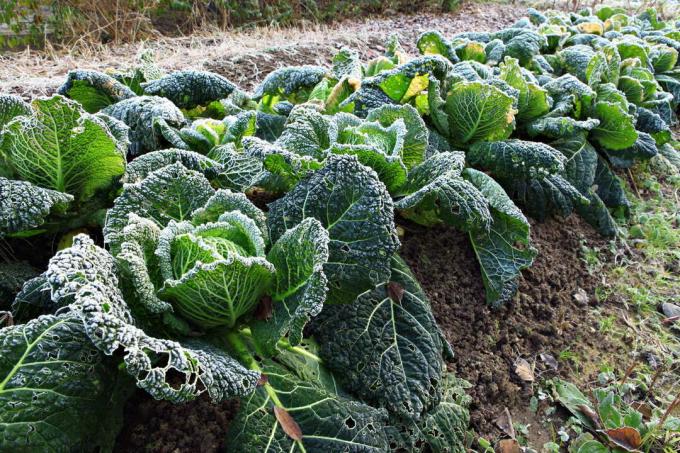
If you want to go one step further and not only buy seasonal vegetables, but even grow them yourself, you will find them in our sowing calendar all information and tips on which plants are sown when in the year.
